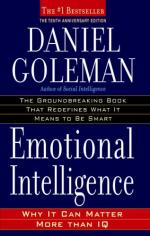
|
| Name: _________________________ | Period: ___________________ |
This test consists of 5 multiple choice questions, 5 short answer questions, and 10 short essay questions.
Multiple Choice Questions
1. Dr. Charles Nemeroff is best known for his work in treating what?
(a) Ekbom syndrome.
(b) Paraphilia.
(c) Pyromania.
(d) Depression.
2. Aside from social changes, the glue that holds a couple together is what, according to the author in Part Three: Chapter 9, “Intimate Enemies”?
(a) Money.
(b) Inherited traits.
(c) Emotional intelligence.
(d) Christian beliefs.
3. What psychologist at the University of Texas summarizes his research by reporting that women want to talk to make an emotional connection, but men want to make a connection by doing things together?
(a) Robert Ader.
(b) John Mayer.
(c) Ted Huston.
(d) C. R. Snyder.
4. According to the author in Part Five: Chapter 15, “The Cost of Emotional Illiteracy,” alcoholics tend to have a biological marker of under-producing what neurotransmitter that regulates anxiety?
(a) GABA.
(b) Glutamate.
(c) Norepinephrine.
(d) Dopamine.
5. According to the author in “Part Three: Chapter 9, “Intimate Enemies,” boys honor independence while girls treasure what?
(a) Rationality.
(b) Survival.
(c) Confidence.
(d) Connectedness.
Short Answer Questions
1. Following criticism from Senator Charles Grassley of the Senate Finance Committee, Nemeroff resigned as chair of the psychiatry department at what institution?
2. At what institution does Dr. Redford Williams work?
3. Where did Dr. Charles Nemeroff earn his Ph.D. in neurobiology?
4. The neocortex in humans is _____ than in other species.
5. Jerome Kagan found four temperamental types that have different patterns of brain activity. What is the third described in Part Four: Chapter 14, “Temperament Is Not Destiny”?
Short Essay Questions
1. What advice does Harry Levinson give to managers on coaching employees in Part Three: Chapter 10, “Managing with Heart”?
2. Harvard pediatrician T. Berry Brazelton found through research that a child's readiness for learning is based on seven key factors. What are they?
3. What did Leslie Brody and Judith Hall discover about the developmental differences between boys and girls?
4. What biological explanation does Dr. Charles Nemeroff give for PTSD in Part Four: Chapter 13, “Trauma and Emotional Relearning”?
5. How does the author describe the “healthy” and “unhealthy” ways of arguing in Part Three: “Chapter 9, Intimate Enemies”?
6. What is the impact of emotional illiteracy, according to the author in Part Five: Chapter 15, “The Cost of Emotional Illiteracy”?
7. How does family impact a child’s development of emotional intelligence?
8. What program of John Lochman’s is decribed in Part Five: Chapter 15, “The Cost of Emotional Illiteracy”? What were the results of the program?
9. What study did Hilda Bruch develop in the 1960s? What discoveries did she make?
10. What three toxic parenting styles are described in Part Four: Chapter 12, “The Family Crucible”? Who identified these styles?
|
This section contains 826 words (approx. 3 pages at 300 words per page) |

|




